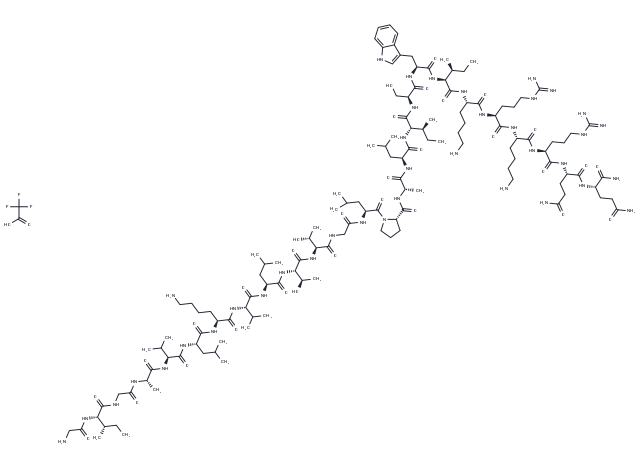keep away from moisture
Powder: -20°C for 3 years | In solvent: -80°C for 1 year

Melittin TFA is a small protein containing 26 amino acid residues, is the principal toxic component of bee venom. Melittin is a PLA2 activator, stimulates the activity of the low molecular weight PLA2, while it does not the increase activity of the high molecular weight PLA2.

| Pack Size | Availability | Price/USD | Quantity |
|---|---|---|---|
| 1 mg | In stock | $ 119.00 | |
| 5 mg | In stock | $ 289.00 | |
| 10 mg | In stock | $ 476.00 | |
| 25 mg | In stock | $ 778.00 | |
| 50 mg | In stock | $ 1,090.00 | |
| 100 mg | In stock | $ 1,470.00 |


| Description | Melittin TFA is a small protein containing 26 amino acid residues, is the principal toxic component of bee venom. Melittin is a PLA2 activator, stimulates the activity of the low molecular weight PLA2, while it does not the increase activity of the high molecular weight PLA2. |
| In vitro | Melittin, an immunologically related PLA2 stimulating peptide from bee venom, increases the activity of the high molecular weight enzyme[1]. Melittin is a cytotoxic peptide from bee venom. Melittin exhibits toxicity against both A2780CR and A2780 cells, with IC50 values of 4.5 and 6.8 μg/mL, respectively. Melittin has natural anti-bacterial, anti-viral, and anti-inflammatory properties. It has also been shown to have diverse anticancer effects in several different cancer cell lines including those of gastric, breast, ovarian, liver, prostate, cervical, and lung origins. The mechanisms by which Melittin, an amphipathic haemolytic peptide, exerts its potential anticancer effects include inhibition of cell proliferation, induction of apoptosis, and direct necrosis. Melittin can also prevent EGF-induced cell invasion through its inhibition of the PI3K/Akt/mTOR signaling pathway, but this is primarily related to breast cancer cells[2]. |
| Molecular Weight | 2960.54 |
| Formula | C133H230F3N39O33 |
| CAS No. | TP1299L |
keep away from moisture
Powder: -20°C for 3 years | In solvent: -80°C for 1 year
DMSO: 5 mM
H2O: 20 mM
You can also refer to dose conversion for different animals. More
bottom
Please see Inhibitor Handling Instructions for more frequently ask questions. Topics include: how to prepare stock solutions, how to store products, and cautions on cell-based assays & animal experiments, etc.
Melittin TFA(20449-79-0(free base)) TP1299L Metabolism Phospholipase Melittin TFA(20449 79 0(free base)) Melittin TFA(20449790(free base)) inhibitor inhibit
